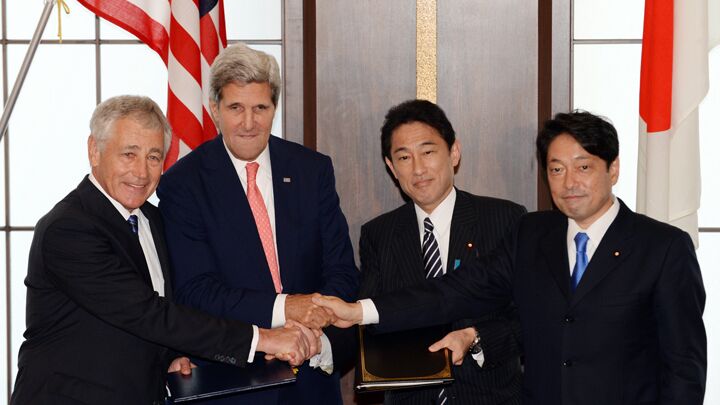
Tokyo and Washington Update Military Cooperation Pact
The Military cooperation pact between Japan and the United States is undergoing big changes. As a result, for the first time since World War ii, Japan could soon officially be allowed to have first-strike capabilities against potential threats.
Last Thursday, U.S. Defense Secretary Chuck Hagel and Secretary of State John Kerry met with their Japanese counterparts in Tokyo to discuss the regional security pact between the two sides. It is significant that while all previous meetings about the defense pact were called by the U.S., this one was called by Japan.
Japanese officials deployed plenty of the usual rhetoric about wanting the U.S. to continue to ensure security in East Asia. After the meeting, however, Tokyo said it will foot a $3.1 billion bill to cover part of the cost to move 9,000 American troops out of Okinawa. This move reveals Japan’s eagerness to break free of the U.S. military and is only the first of many steps it will take to get American soldiers off its turf.
Japan’s real purpose in calling for the update was to expand its own military role in the region. A joint statement released after the meeting showed that Tokyo made progress toward that goal. Washington “welcomed” Japan’s efforts to lift its ban on exercising the right to collective self-defense, the statement said.
In the lead-up to the conference, an unnamed Pentagon source said the two sides would also “start the process for reviewing” the lifting of another, more significant ban: the one outlawing Japan’s first-strike capabilities. Although statements released after the meeting made no mention of lifting this ban, the wheels of this monumental change may well be in motion.
The ban was imposed in the aftermath of World War ii, when nothing short of two nuclear bombs was able to bring a halt to Japan’s devastating military machine. The ban technically limits Japan to hosting a self-defense force.
To avoid stirring fears of a resurgence in Japanese militarism, post-war Tokyo has relied on Washington for security guarantees. Now, however, three factors are making Japan less concerned about trying to allay global fears about a revival of its militaristic nationalism: Japan’s dwindling faith in America’s security promises; its rising tensions with China and the Koreas; and its desire to be looked upon as a world power in its own right, complete with the ability to defend its national interests militarily.
These factors have prompted Prime Minister Shinzo Abe and other nationalists to intensify efforts to define Japan’s military as a full-fledged force. Now, as the unnamed Pentagon official’s report indicates, U.S. authorities are responding to those efforts.
As significant as such a change in the official Japan-U.S. security pact would be, however, the reality is that Japan has long been building a military capable of much more than defense. As Trumpet columnist Ron Fraser recently explained:
The reality is that the sheer strength of current Japanese military power—let alone its potential for rapid growth—belies the intent of Article 9 of its constitution, the clause that ostensibly restricts Japan to mounting a force of a nature sufficient for the self-defense of its immediate geographic arena. … [U]nder the cloak of Article 9 of its constitution, Japan—entirely of its own initiative and in its own national interest—has built one of the most powerful military forces in the world, a force with the capability of power projection far beyond the realm of self-defense. How soon will the world wake up to the fiction that a pacifist Japan continues to be content with a military role of purely self-defense?
The updates to the security pact and other shifting tides in Asian geopolitics have sobering implications for the short term, but Bible prophecy makes plain that they immediately precede the most hope-filled event ever to occur. To understand more, read “The Fiction of Japan’s Defense Force.”
